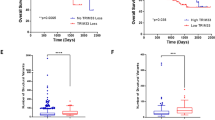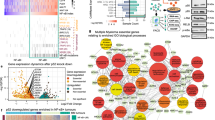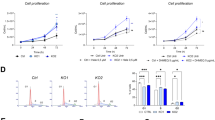Abstract
Deletion or mutation of the gene encoding the deubiquitinating enzyme CYLD is a common genomic aberration in multiple myeloma (MM). However, the functional consequence of CYLD loss and the mechanism underlying its putative role as a tumor suppressor gene in the pathogenesis of MM has not been established. Here, we show that CYLD expression is highly variable in myeloma cell lines and primary MMs and that low CYLD expression is associated with disease progression from monoclonal gammopathy of undetermined significance to MM, and with poor overall and progression free-survival of MM patients. Functional assays revealed that CYLD represses MM cell proliferation and survival. Furthermore, CYLD acts as a negative regulator of NF-κB and Wnt/β-catenin signaling and loss of CYLD sensitizes MM cells to NF-κB-stimuli and Wnt ligands. Interestingly, in primary MMs, low CYLD expression strongly correlated with a proliferative and Wnt signaling-gene expression signature, but not with an NFκB target gene signature. Altogether, our findings identify CYLD as a negative regulator of NF-κB and Wnt/β-catenin signaling in MM and indicate that loss of CYLD enhances MM aggressiveness through Wnt pathway activation. Thus, targeting the Wnt pathway could be a promising therapeutic strategy in MM with loss of CYLD activity.
This is a preview of subscription content, access via your institution
Access options
Subscribe to this journal
Receive 50 print issues and online access
$259.00 per year
only $5.18 per issue
Buy this article
- Purchase on Springer Link
- Instant access to full article PDF
Prices may be subject to local taxes which are calculated during checkout






Similar content being viewed by others
References
Hideshima T, Mitsiades C, Tonon G, Richardson PG, Anderson KC . Understanding multiple myeloma pathogenesis in the bone marrow to identify new therapeutic targets. Nat Rev Cancer. 2007; 7: 585–598.
Kuehl WM, Bergsagel PL . Molecular pathogenesis of multiple myeloma and its premalignant precursor. J Clin Invest 2012; 122: 3456–3463.
Kumar S, Fonseca R, Ketterling RP, Dispenzieri A, Lacy MQ, Gertz MA et al. Trisomies in multiple myeloma: impact on survival in patients with high-risk cytogenetics. Blood 2013; 119: 2100–2105.
Morgan GJ, Walker BA, Davies FE . The genetic architecture of multiple myeloma. Nat Rev Cancer 2012; 12: 335–348.
Lawasut P, Groen RW, Dhimolea E, Richardson PG, Anderson KC, Mitsiades CS . Decoding the pathophysiology and the genetics of multiple myeloma to identify new therapeutic targets. Semin Oncol 2013; 40: 537–548.
Lohr JG, Stojanov P, Carter SL, Cruz-Gordillo P, Lawrence MS, Auclair D et al. Widespread genetic heterogeneity in multiple myeloma: implications for targeted therapy. Cancer Cell 2014; 25: 91–101.
Jenner MW, Leone PE, Walker BA, Ross FM, Johnson DC, Gonzalez D et al. Gene mapping and expression analysis of 16q loss of heterozygosity identifies WWOX and CYLD as being important in determining clinical outcome in multiple myeloma. Blood 2007; 110: 3291–3300.
Bignell GR, Warren W, Seal S, Takahashi M, Rapley E, Barfoot R et al. Identification of the familial cylindromatosis tumour-suppressor gene. Nat Genet 2000; 25: 160–165.
Espinosa L, Cathelin S, D'Altri T, Trimarchi T, Statnikov A, Guiu J et al. The Notch/Hes1 pathway sustains NF-kappaB activation through CYLD repression in T cell leukemia. Cancer Cell 2010; 18: 268–281.
Hellerbrand C, Bumes E, Bataille F, Dietmaier W, Massoumi R, Bosserhoff AK . Reduced expression of CYLD in human colon and hepatocellular carcinomas. Carcinogenesis 2007; 28: 21–27.
Massoumi R, Kuphal S, Hellerbrand C, Haas B, Wild P, Spruss T et al. Down-regulation of CYLD expression by Snail promotes tumor progression in malignant melanoma. J Exp Med 2009; 206: 221–232.
Annunziata CM, Davis RE, Demchenko Y, Bellamy W, Gabrea A, Zhan F et al. Frequent engagement of the classical and alternative NF-kappaB pathways by diverse genetic abnormalities in multiple myeloma. Cancer Cell 2007; 12: 115–130.
Keats JJ, Fonseca R, Chesi M, Schop R, Baker A, Chng WJ et al. Promiscuous mutations activate the noncanonical NF-kappaB pathway in multiple myeloma. Cancer Cell 2007; 12: 131–144.
Walker BA, Boyle EM, Wardell CP, Murison A, Begum DB et al. Mutational Spectrum, Copy Number Changes, and Outcome: Results of a Sequencing Study of Patients With Newly Diagnosed Myeloma. J Clin Oncol 2015; 33: 3911–3920.
Brummelkamp TR, Nijman SM, Dirac AM, Bernards R . Loss of the cylindromatosis tumour suppressor inhibits apoptosis by activating NF-kappaB. Nature 2003; 424: 797–801.
Kovalenko A, Chable-Bessia C, Cantarella G, Israël A, Wallach D, Courtois G . The tumour suppressor CYLD negatively regulates NF-kappaB signalling by deubiquitination. Nature 2003; 424: 801–805.
Massoumi R, Chmielarska K, Hennecke K, Pfeifer A, Fässler R . Cyld inhibits tumor cell proliferation by blocking Bcl-3-dependent NF-kappaB signaling. Cell 2006; 125: 665–677.
Reiley WW, Jin W, Lee AJ, Wright A, Wu X, Tewalt EF et al. Deubiquitinating enzyme CYLD negatively regulates the ubiquitin-dependent kinase Tak1 and prevents abnormal T cell responses. J Exp Med 2007; 204: 1475–1485.
Wright A, Reiley WW, Chang M, Jin W, Lee AJ, Zhang M et al. Regulation of early wave of germ cell apoptosis and spermatogenesis by deubiquitinating enzyme CYLD. Dev Cell 2007; 13: 705–716.
Lim JH, Jono H, Komatsu K, Woo CH, Lee J, Miyata M et al. CYLD negatively regulates transforming growth factor-β-signalling via deubiquitinating Akt. Nat Commun 2012; 10: 771.
Rajan N, Elliott RJ, Smith A, Sinclair N, Swift S, Lord CJ et al. The cylindromatosis gene product, CYLD, interacts with MIB2 to regulate notch signaling. Oncotarget 2014; 5: 12126–12140.
Tauriello DV, Haegebarth A, Kuper I, Edelmann MJ, Henraat M, Canninga-van Dijk MR et al. Loss of the tumor suppressor CYLD enhances Wnt/beta-catenin signaling through K63-linked ubiquitination of Dvl. Mol Cell 2010; 37: 607–619.
An CH, Kim SS, Kang MR, Kim YR, Kim HS, Yoo NJ et al. Frameshift mutations of ATBF1, WNT9A, CYLD and PARK2 in gastric and colorectal carcinomas with high microsatellite instability. Pathology 2010; 42: 583–585.
Massoumi R . CYLD: a deubiquitination enzyme with multiple roles in cancer. Future Oncol 2011; 7: 285–297.
Iliopoulos D, Jaeger SA, Hirsch HA, Bulyk ML, Struhl K . STAT3 activation of miR-21 and miR-181b-1 via PTEN and CYLD are part of the epigenetic switch linking inflammation to cancer. Mol Cell 2010; 39: 493–506.
Hutti JE, Shen RR, Abbott DW, Zhou AY, Sprott KM, Asara JM et al. Phosphorylation of the tumor suppressor CYLD by the breast cancer oncogene IKKepsilon promotes cell transformation. Mol Cell 2009; 34: 461–472.
Zhan F, Huang Y, Colla S, Stewart JP, Hanamura I, Gupta S et al. The molecular classification of multiple myeloma. Blood 2006; 108: 2020–2028.
Sonneveld P, Schmidt-Wolf IG, van der Holt B, El Jarari L, Bertsch U, Salwender H et al. Bortezomib induction and maintenance treatment in patients with newly diagnosed multiple myeloma: results of the randomized phase III HOVON-65/ GMMG-HD4 Trial. J Clin Oncol 2012; 30: 2946–2955.
Mulligan G, Mitsiades C, Bryant B, Zhan F, Chng WJ, Roels S et al. Gene expression profiling and correlation with outcome in clinical trials of the proteasome inhibitor bortezomib. Blood 2007; 109: 3177–3188.
Derksen PW, Tjin E, Meijer HP, Klok MD, MacGillavry HD, van Oers MH et al. Illegitimate WNT signaling promotes proliferation of multiple myeloma cells. Proc Natl Acad Sci USA 2004; 101: 6122–6127.
de Lau W, Barker N, Low TY, Koo BK, Li VS et al. Lgr5 homologues associate with Wnt receptors and mediate R-spondin signalling. Nature 2011; 476: 293–297.
Carmon KS, Gong X, Lin Q, Thomas A, Liu Q . R-spondins function as ligands of the orphan receptors LGR4 and LGR5 to regulate Wnt/beta-catenin signaling. Proc Natl Acad Sci USA 2011; 108: 11452–11457.
Smith EM, Zhang L, Walker BA, Davenport EL, Aronson IL, Krige D et al. The combination of HDAC and aminopeptidase inhibitors is highly synergistic in myeloma and leads to disruption of the NFκB signalling pathway. Oncotarget 2015; 6: 17314–17327.
Dutta-Simmons J, Zhang Y, Gorgun G, Gatt M, Mani M, Hideshima T et al. Aurora kinase A is a target of Wnt/beta-catenin involved in multiple myeloma disease progression. Blood 2009; 114: 2699–2708.
Takada K, Zhu D, Bird GH, Sukhdeo K, Zhao JJ . Targeted disruption of the BCL9/β-catenin complex inhibits oncogenic Wnt signaling. Sci Transl Med 2012; 4: 148ra117.
Sukhdeo K, Mani M, Zhang Y, Dutta J, Yasui H, Rooney MD et al. Targeting the beta-catenin/TCF transcriptional complex in the treatment of multiple myeloma. Proc Natl Acad Sci USA 2007; 104: 7516–7521.
Kocemba KA, Groen RW, van Andel H, Kersten MJ, Mahtouk K, Spaargaren M et al. Transcriptional silencing of the Wnt-antagonist DKK1 by promoter methylation is associated with enhanced Wnt signaling in advanced multiple myeloma. PLOS One 2012; 7: e30359.
Van Den Berg DJ, Sharma AK, Bruno E, Hoffman R . Role of members of the Wnt gene family in human hematopoiesis. Blood 1998; 92: 3189–3202.
Chim CS, Pang R, Fung TK, Choi CL, Liang R . Epigenetic dysregulation of Wnt signaling pathway in multiple myeloma. Leukemia 2007; 21: 2527–2536.
Jost E, Gezer D, Wilop S, Suzuki H, Herman JG, Osieka R, Galm O . Epigenetic dysregulation of secreted Frizzled-related proteins in multiple myeloma. Cancer Lett 2009; 281: 24–31.
Sanjana NE, Shalem O, Zhang F . Improved vectors and genome-wide libraries for CRISPR screening. Nat Methods 2014; 11: 783–784.
Winterhalter C, Widera P, Krasnogor N . JEPETTO: a Cytoscape plugin for gene set enrichment and topological analysis based on interaction networks. Bioinformatics 2014; 30: 1029–1030.
Acknowledgements
This study was supported by grants from the Dutch Cancer Society and EU-FP7 OVER-MYR.
Author contributions
HvA and KAK performed most in vitro experiments, analyzed the data, designed the figures and wrote the paper; AH-K provided technical assistance. CHM performed aCGH; AB, MvD and MP provided micro-array data and performed statistical analysis; PS supervised AB and MvD and reviewed the manuscript. MM provided CYLD reagents and expertize and reviewed the manuscript; MJK provided patient samples and reviewed the manuscript. MS and STP designed the research, supervised the study, analyzed the data. STP wrote the paper.
Author information
Authors and Affiliations
Corresponding author
Ethics declarations
Competing interests
The authors declare no conflict of interest.
Additional information
Supplementary Information accompanies this paper on the Oncogene website
Rights and permissions
About this article
Cite this article
van Andel, H., Kocemba, K., de Haan-Kramer, A. et al. Loss of CYLD expression unleashes Wnt signaling in multiple myeloma and is associated with aggressive disease. Oncogene 36, 2105–2115 (2017). https://doi.org/10.1038/onc.2016.368
Received:
Revised:
Accepted:
Published:
Issue Date:
DOI: https://doi.org/10.1038/onc.2016.368
This article is cited by
-
MALT1-dependent cleavage of CYLD promotes NF-κB signaling and growth of aggressive B-cell receptor-dependent lymphomas
Blood Cancer Journal (2023)
-
Down-regulation of cylindromatosis protein phosphorylation by BTK inhibitor promotes apoptosis of non-GCB-diffuse large B-cell lymphoma
Cancer Cell International (2021)
-
Deubiquitinases in hematological malignancies
Biomarker Research (2021)
-
MicroRNAs as the critical regulators of cisplatin resistance in gastric tumor cells
Genes and Environment (2021)
-
Reversal of CYLD phosphorylation as a novel therapeutic approach for adult T-cell leukemia/lymphoma (ATLL)
Cell Death & Disease (2020)



